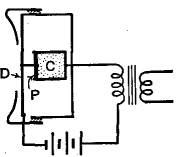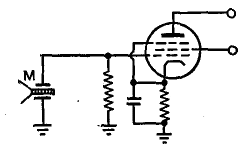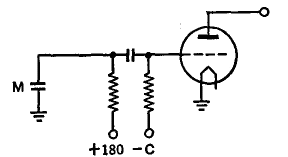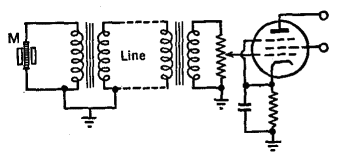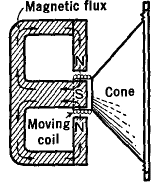| Basic Radio is a free introductory textbook on electronics based on tubes. See the editorial for more information.... |

|

Home  Amplifiers Amplifiers  Audio-Frequency Amplifiers Audio-Frequency Amplifiers  Microphones Microphones |
||||||||||||||






|
||||||||||||||
|
MicrophonesAuthor: J.B. Hoag The construction of a single-button carbon microphone is shown in Fig. 25 I.
The current through these microphones is usually 50 to 100 ma. The output voltage of a single-button microphone amounts to from 0.1 to 0.3 volt across the 50- to 100-ohm primary of the transformer. A peak voltage of 3 to 10 volts will be developed across a 100,000-ohm load on the transformer secondary. With double-button microphones, 0.02 to 0.07 volt is developed across the 200-ohm primary and 0.4 to 0.5 volt is produced across a 100,000-ohm secondary load. Operating currents are usually from 5 to 50 ma. per button. The double-button type is less noisy than the single-button type. Crystal microphones contain a pair of Rochelle salt crystals, properly cemented together, and with terminals of metal plated directly on their surfaces. The crystal is fastened directly to a diaphragm in the more sensitive types. When sound waves vibrate the crystal, changing its physical dimensions, small alternating potentials are produced between the electrodes (piezo-electric effect). These are applied to the amplifying tube directly, without the aid of a microphone battery, as shown in Fig. 25 K.
The output voltage usually ranges from 0.01 to 0.03 volt. High values (1 to 5 megohms) of the grid resistor of the pentode should be used. A condenser microphone consists of a rigid metal plate in front of which, at a distance of about 0.001 in., is mounted a thin metal diaphragm, everywhere parallel to the plate. A d.c. voltage (180) is applied to this condenser, as in Fig. 25 L.
When sound waves vibrate the thin membrane, the capacity changes and causes a fluctuating charge and discharge current to flow through the coupling resistor. The voltage across this resistor is then amplified by a tube. This tube must be mounted close to the microphone in order to avoid losses in the capacitance of a connecting cable. The better condenser microphones are from 1/100 to 1/50 as sensitive as the double-button type. Velocity or ribbon microphones have a thin, corrugated metal ribbon suspended between the poles of a magnet. When sound waves vibrate the ribbon back and forth in the magnetic field, cutting its lines of force and generating an e.m.f. in the ribbon, voltages of the order of magnitude of 0.03 to 0.05 volt are generated. An input circuit for this type of microphone is shown in Fig. 25 M.
The dynamic microphone uses a coil of wire, mechanically coupled to the diaphragm, and free to vibrate in a strong magnetic field. The use of several turns of wire in the coil permits this type to deliver a larger output voltage than the ribbon type. For crude work, a small, permanent-magnet dynamic loudspeaker may be used as a microphone. The construction of such a loudspeaker is shown in Fig. 25 N.
|
||||||||||||||
Home  Amplifiers Amplifiers  Audio-Frequency Amplifiers Audio-Frequency Amplifiers  Microphones Microphones |
||||||||||||||
Last Update: 2010-11-21


